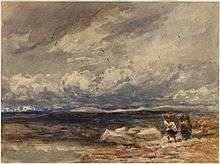Besom
A besom /ˈbiːzəm/ is a broom, a household implement used for sweeping. The term is now mostly reserved for a traditional broom constructed from a bundle of twigs tied to a stout pole. The twigs used could be broom (i.e. Genista, from which comes the modern name "broom" for the tool), heather or similar. The song "Buy Broom Buzzems" from Northern England refers to both types of twig. From the phrase broom besom the more common broom comes. In Scotland, besoms are still occasionally to be found at the edge of forests where they are stacked for use in early response to an outbreak of fire.



Description
As a result of its construction around a central pole, the brush of the besom is rounded instead of flat. The bristles can be made of many materials including, but not limited to straw, herbs, or twigs. Traditionally the handle is of hazel wood and the head is of birch twigs. Modern construction uses bindings of wire and string (instead of the traditional split withy) and the head is secured by a steel nail instead of a wooden dowel.
In Wicca
A besom is a tool used in Wicca to cleanse and purify a space which will be used for ritual. A traditional Wiccan besom is a hawthorn stave handle with bristles made from birch twigs. These twigs are tied on using thin pieces of willow wood. It is used to cleanse the ritual area before circle casting. While it does not usually touch the ground, it is used to "sweep out" the negative energies in a room, and is often held a few inches above the ground to do so. As a tool, the besom is usually thought of as masculine in nature due to its phallic shape and symbolism. However the besom's components are of both masculine and feminine orientation.[1] The handle, an ash stave, is masculine in nature while the birch used for the bristles is thought of as feminine in nature. The besom is thought to be involved with fairies.
The besom is an important part of Wiccan handfasting ceremonies in some traditions. The couple jump over the besom during the ceremony. Alternatively, the couple may jump over a small bonfire.
Besoms and flying
There is a theory that the origin of the idea of witches flying with their brooms is based in a ritual involving a psychoactive drug trip.[2] The witches would prepare a flying ointment to aid them in their journey. There are many recipes for this ointment all having a base of either Atropa belladonna or Mandragora officinarum, both highly psychoactive drugs producing visions and encouraging astral projection.[3] Some speculate the ointment was applied to the end of the Besom and administered vaginally.[4] Witches mounted broomsticks and would leap around the fields, hallucinating with the aid of the flying ointment, in order to "teach the crops how high to grow". The ointment would give them hallucinations, which made them believe that they flew distances.[5]
References
- Gladheart, Friday. "Besom Briefs". PaganPath.com. Retrieved 19 February 2014.
- Adams, Cecil (September 3, 1999). "What's the deal with witches and broomsticks?". Retrieved 3 March 2012.
- Powell, Shantell (1998). "Flying Potions and Getting to the Sabbat". Archived from the original on 13 July 2004. Retrieved 6 August 2009.
- Kroll, David (October 31, 2017). "The Origin of Witches Riding Broomsticks: Drugs from Nature, Plus Shakespeare". Retrieved 31 May 2019.
- of Worms Abraham ben Simeon (2004). Mathers, S. L. MacGregor (ed.). The Book Of The Sacred Magic Of Abramelin The Mage (Illustrated ed.). Book Tree. ISBN 9781585092529.
External links
| Look up besom in Wiktionary, the free dictionary. |
- . Encyclopædia Britannica (11th ed.). 1911.
